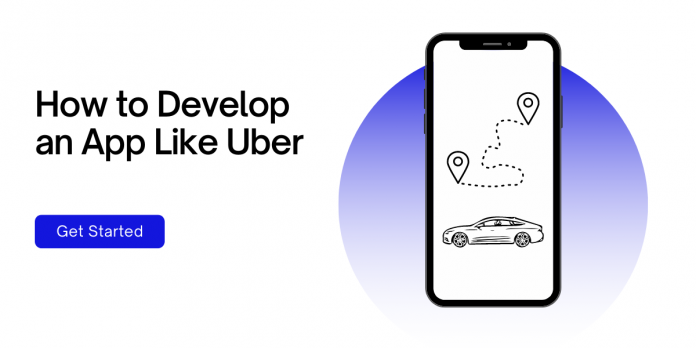The emergence of taxi cab apps has revolutionized the transportation industry by providing a more efficient and convenient way for passengers to book and pay for rides. These apps, such as the Uber app concept, Lyft, and Grab, have disrupted traditional taxi services and created a new era of transportation.
In this context, building an app like Uber has become a lucrative business idea for entrepreneurs and investors. And that’s what we will discuss in this blog.
The Need for Uber App Concept in
There are several reasons why building the Uber app concept is a lucrative business idea. First, the demand for ride-hailing services continues to grow globally, creating a huge market opportunity. According to a report by Allied Market Research, the global ride-hailing market was valued at $36.45 billion in 2017 and is projected to reach $126.52 billion by 2025.
Second, ride-hailing apps have low barriers to entry, making it easier for entrepreneurs to start a business in this space. With the availability of affordable and user-friendly app development tools, entrepreneurs can develop an app like Uber with minimal upfront costs.
Additionally, ride-hailing apps offer a flexible business model that allows entrepreneurs to scale their businesses quickly. They can easily expand their service coverage, onboard new drivers, and offer new services to meet changing customer needs.
How to Build an App on the Uber App Concept
Let’s take a look at the steps of how an app like Uber can be created.
1. Market Research
Market research is a crucial step in building an app on the Uber app concept. It involves analyzing the competition and identifying gaps in the market, as well as understanding the target audience and their needs.
i. Analyzing the Competition and Identifying Gaps in the Market
Before developing an app like Uber, it is important to conduct a competitive analysis to understand the strengths and weaknesses of existing ride-hailing apps. This analysis will help identify gaps in the market that can be addressed by the new app. Some of the factors to consider in a competitive analysis include pricing, service coverage, driver incentives, and user experience.
For example, if existing ride-hailing apps in a particular market are charging high prices and providing poor service, a new app could offer lower prices and better service to attract customers. Similarly, if existing apps are not offering services to certain areas or are not providing enough incentives to drivers, a new app could address these gaps to gain a competitive advantage.
ii. Understanding the Target Audience and Their Needs
To build an app on the Uber app concept that resonates with users, it is important to not only understand the target audience and their needs but also conduct market research to gather insights into user behavior, preferences, and pain points. This involves considering factors such as age, gender, income, and lifestyle to gain a comprehensive understanding of the target audience.
For example, if the target audience is young professionals who use ride-hailing apps for daily commutes, the app could offer features such as scheduled pickups, flexible payment options, and rewards programs to encourage loyalty. Similarly, if the target audience is tourists who use ride-hailing apps for sightseeing, the app could offer features such as customized tour packages and multilingual support to enhance the user experience.
Related – Quick Guide to Preparing the Mobile App Development Scope of Work
2. Key Features of the App
When building an app on the Uber app concept, it is important to include key features that provide a seamless and user-friendly experience for passengers and drivers. Here are some of the essential features to consider:
i. User Registration and Profile Creation
To use the app, passengers and drivers must not only register and create a profile but also provide their personal information, payment details, and preferences. This feature makes it easier for the app to match them with the right driver or passenger.
ii. Ride-hailing Functionality
The core feature of an app based on the Uber app concept is ride-hailing functionality. This feature allows passengers to request a ride and drivers to accept the ride request. The app should also provide information about the estimated time of arrival (ETA) and the driver’s details, such as their name and vehicle type.
iii. GPS Tracking and Real-Time Driver Location
To provide a seamless ride experience, the app should have GPS tracking and real-time driver location features. This allows passengers to track the driver’s location and ETA, as well as provides drivers with real-time traffic updates and directions to the pickup location.
iv. Payment Gateway Integration
The app should have a payment gateway integration that allows passengers to pay for rides seamlessly. This feature should support multiple payment options, such as credit cards, debit cards, and mobile wallets, to cater to different user preferences.
v. Rating and Feedback System
To ensure quality and safety, not only should the app have a rating and feedback system that allows passengers to rate their ride experience and provide feedback, but this feature also helps to maintain high-quality service standards and enables drivers to improve their performance.
vi. Admin Dashboard for Managing Users and Rides
Finally, the app should have an admin dashboard that allows the app owner to manage users and rides efficiently. This feature should provide real-time data on ride bookings, user behavior, and driver performance, as well as enable the app owner to manage payments, incentives, and refunds.
Related – Understanding the Software Development Lifecycle (SDLC)
3. Technical Requirements

Building an app on the Uber app concept requires careful consideration of various technical requirements. Here are some of the key technical requirements to keep in mind:
i. Choosing the Right Platform and Programming Language
Choosing the right platform and programming language is critical to building a scalable and reliable app. Most ride-hailing apps are developed for iOS and Android platforms, which have different programming languages and development tools. Choosing the right programming language, such as Java or Swift, is also essential to ensure the app’s compatibility with different devices and operating systems.
ii. Cloud Hosting and Data Storage
To handle large volumes of data and provide a seamless experience, the app should be hosted on a cloud platform. Cloud hosting offers several benefits, such as scalability, reliability, and cost-effectiveness. Additionally, the app should have robust data storage capabilities that can store user data, ride history, and other critical information securely.
API integrations with payment gateways, Google Maps, and other third-party services:
The app should have API integrations with payment gateways, such as Stripe or PayPal, to facilitate secure and seamless payment transactions. Additionally, integrating Google Maps or other mapping services can provide real-time traffic updates and directions, making it easier for drivers to navigate and find pickup locations.
iii. Security Considerations and Data Protection Measures
Ensuring the security and protection of user data is critical when building an app like Uber. The app should have robust security measures, such as encryption and two-factor authentication, to prevent unauthorized access and data breaches. Additionally, the app should comply with data protection regulations, such as GDPR and CCPA, to safeguard user data and privacy.
If your business requires technical assistance or looking to hire app developers in Singapore, feel free to contact us and get a free consultation.
4. UI/UX Design
The UI/UX design of an app on the Uber app concept is crucial in providing a seamless and intuitive experience for users. Here are some of the key aspects to consider when designing the app’s interface:
i. Creating a user-friendly Interface and Intuitive Navigation
The app’s interface should not only be user-friendly but also have easy-to-use navigation that makes it simple for users to book rides, view ride history, and manage their profiles. Moreover, it should be designed with a focus on ease of use, speed, and accessibility.
ii. Designing for Different Screen Sizes and Devices
As ride-hailing apps are used across different devices, not only is it important to ensure that the app’s interface is responsive and adapts to different screen sizes, but the app’s design should also be optimized for mobile devices, with clear and easy-to-read text and graphics.
iii. Incorporating Branding and Visual Elements
The app’s visual design should incorporate the brand’s visual identity, such as the logo, colors, and typography, to create a consistent and recognizable brand image. The app’s visual design should also be visually appealing, with a modern and clean aesthetic that is easy on the eyes.
iv. Providing Clear and Concise Information
The app’s design should not only provide users with clear and concise information about ride options, pricing, and driver details but also include providing information about estimated arrival times, driver ratings, and the driver’s car model.
v. Streamlining the Booking Process
The app’s design should streamline the booking process by reducing the number of clicks required to book a ride. Additionally, this includes using predictive text, suggesting pickup and dropoff locations, and allowing users to save their preferred payment methods.
Related – UI UX Design Process: A Pathway that Experts Follow.
5. Testing and Quality Assurance
Testing and quality assurance are critical components of building an app like Uber. Proper testing can ensure that the app is reliable, secure, and meets the needs of users. Here are some of the key testing and quality assurance measures to consider:
i. Beta Testing and User Feedback
Before launching the app, it is important to conduct beta testing and gather user feedback. Beta testing involves releasing the app to a group of users who provide feedback on the app’s functionality and usability. This feedback can be used to identify bugs, fix issues, and improve the overall user experience.
ii. Performance Testing and Load Testing
Performance testing involves testing the app’s performance under different conditions, such as varying network speeds and traffic volumes. Load testing involves testing the app’s ability to handle large volumes of traffic and data. By conducting these tests, it is possible to identify performance issues and optimize the app’s performance.
iii. Security Testing and Vulnerability Assessment
Security testing involves testing the app’s security measures to identify vulnerabilities and potential threats. This includes testing the app’s encryption, authentication, and data protection measures. Vulnerability assessment involves identifying and addressing potential security threats before they can be exploited by hackers.
iv. Compatibility Testing
Compatibility testing involves testing the app on different devices and operating systems to ensure that it works seamlessly across a range of devices. Additionally, this includes testing the app’s compatibility with different screen sizes, resolutions, and hardware configurations.
6. Launch and Post-Launch Marketing
Launching an app based on the Uber app concept requires a well-planned launch strategy and ongoing marketing efforts to attract and retain users. Here are some key considerations for launch and post-launch marketing:
i. Building a Launch Strategy and Creating Buzz Around the app
Before launching the app, it is important to create a launch strategy that includes building buzz and generating interest among potential users. This can be achieved through PR and media outreach, social media campaigns, and influencer partnerships.
ii. Optimizing the app for Search Engines and App Stores
App store optimization (ASO) involves optimizing the app’s title, description, and keywords to improve its visibility in the app stores. Additionally, this can be complemented with search engine optimization (SEO) efforts to improve the app’s visibility on search engines. As a result, this can drive more organic traffic to the app and increase its discoverability.
iii. Running Targeted Marketing Campaigns to Attract Users
Targeted marketing campaigns can be run to attract users who fit the app’s target demographic. In addition, this can include social media advertising, email marketing, and paid search campaigns. Moreover, targeted marketing campaigns can help to attract users who are more likely to use the app and become loyal customers.
iv. Creating a Plan for Ongoing Maintenance and Updates
Once the app is launched, it is important to have a plan for ongoing maintenance and updates. This includes fixing bugs, addressing user feedback, and adding new features to improve the user experience. Regular updates and maintenance can help to keep the app relevant and ensure that it remains competitive in the market.
Related – How to Market an App: 8 Proven Strategies For App Success
Conclusion
The transportation industry is rapidly evolving, and, consequently, the rise of ride-hailing apps like Uber has disrupted traditional taxi services. As such, there is a significant opportunity for entrepreneurs to invest in the future of transportation technology and build their own ride-hailing apps.
In addition to the potential financial rewards, building an app on the Uber app concept can also contribute to the development of sustainable transportation solutions. By encouraging more people to use ride-hailing apps, it is possible to reduce the number of vehicles on the road and decrease traffic congestion, leading to a more sustainable future for transportation.
Entrepreneurs can take the plunge and invest in the future of transportation technology. Moreover, by building innovative ride-hailing apps like Uber, it is possible to create significant value for users, communities, and the environment. Furthermore, with careful planning and execution, building an app like Uber can be a lucrative and rewarding business opportunity.









